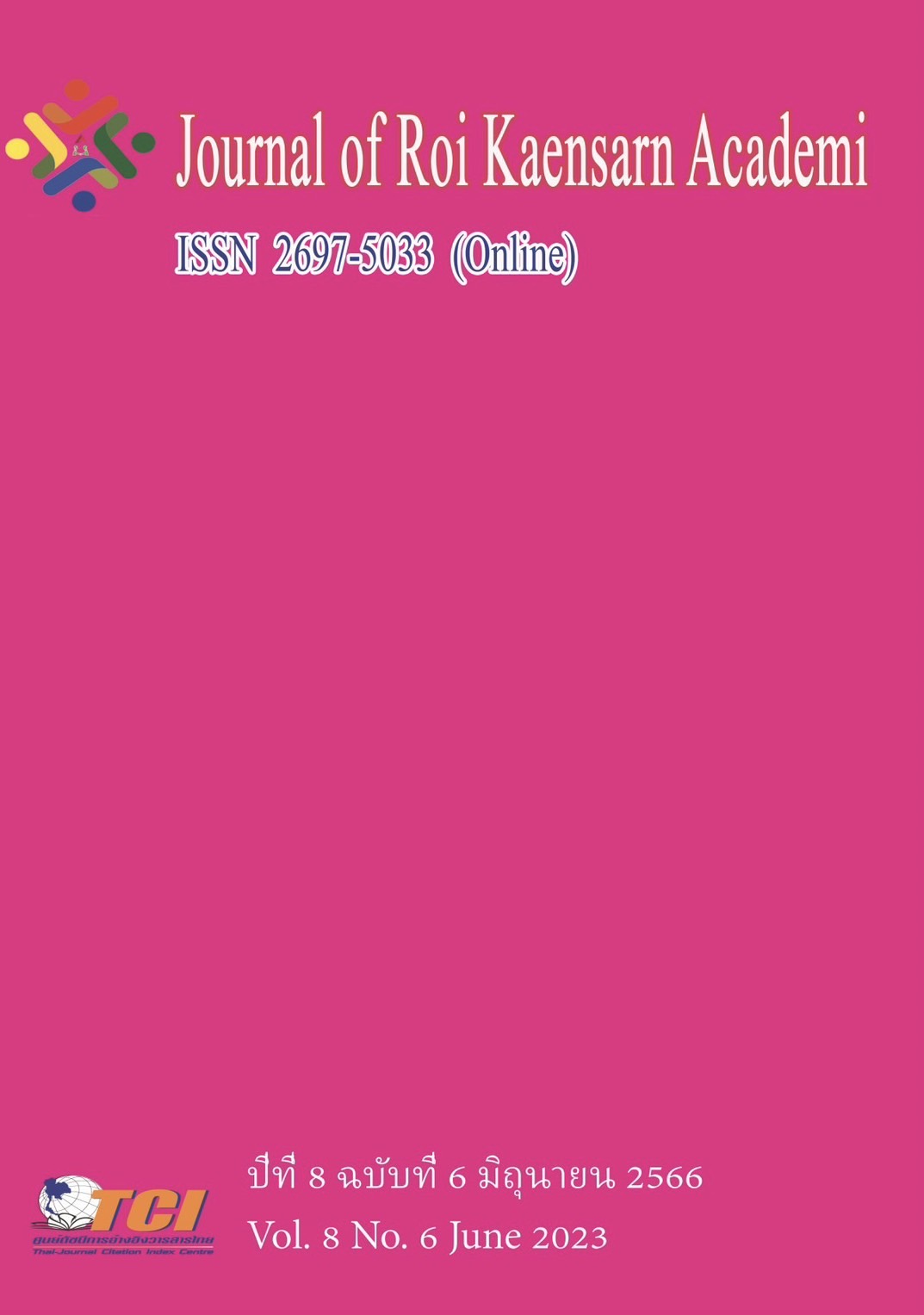การพัฒนากรอบแนวความคิดสมการโครงสร้างสำหรับเศรษฐกิจหมุนเวียนในธุรกิจขนาดกลางและขนาดย่อม
Main Article Content
บทคัดย่อ
The circular economy for Thailand aims to generate economic growth from a diversified resource base, increasing gross domestic product (GDP) growth in four sectors from 3.4 trillion baht, representing 21 percent, to 4.4 trillion. baht or 24 percent, especially in agriculture and food. It was found that the GDP of the agricultural sector from 1.3 trillion baht to 1.6 trillion baht by increasing the variety of agricultural products. There is a decision support system based on consumer behavior analysis technology. (Ministry of Higher Education, 2021)
The objectives of this research were 1) to examine the components of the transition to a circular economy for small and medium enterprises and 2) to analyze the causal relationship of the transition to a circular economy for small and medium enterprises. The quantitative data were collected from 400 small and medium business entrepreneurs in Bangkok and its vicinity. The research tool used in the research was a questionnaire that tested the consistency value between 0.80-1.00. Research statistics contains of factor analysis and path analysis.
The results of the confirmatory factor analysis showed that the P-value passed the acceptable level, the CFI, NFI, GFI and AGFI values between 0.98-0.99 passed the specified criteria, which is greater than 0.90, and the RMR, RMSEA values passed the criteria. As for the results of the path analysis, the fit index for measuring consistency passed the criteria. (Chi-square=238.88, df=115, P-value=0.00, RMSEA=0.058)
Recommendations to create the mindset of environmental conservation. Use renewable materials in the production process. New product creation to create added value Reduce unnecessary production processes in order not to cause any impact on the environment. Including various steps together to create and design new products to add value.
Article Details
เอกสารอ้างอิง
กระทรวงการอุดมศึกษา. (2564). ยุทธศาสตร์ BCG. ออนไลน์. สืบค้นเมื่อ 17 พฤศจิกายน 2565. แหล่งที่มา: https://www.sepo.go.th/assets/document/file/6%20ยุทธศาสตร์%20BCG%20พ.ศ.%202564-2569.pdf
นงลักษณ์ วิรัชชัย. (2542). โมเดลลิสเรล: สถิติวิเคราะห์สำหรับการวิจัย. กรุงเทพมหานคร: โรงพิมพ์แห่งจุฬาลงกรณ์มหาวิทยาลัย.
สำนักงานสภานโยบายการอุดมศึกษา. (2564). เศรษฐกิจหมุนเวียน โอกาสใหม่ของธุรกิจที่สามารถพลิกมาใช้ในชีวิตประจำวัน. ออนไลน์. สืบค้นเมื่อ 17 พฤศจิกายน 2565. แหล่งที่มา: https://www.nxpo. or.th/th/9024/
สุทิน ชนะบุญ. (2560). สถิติและการวิเคราะห์ข้อมูลในงานวิจัยเบื้องต้น. สํานักงานสาธารณสุข จังหวัดขอนแก่น.
สุชาติ ประสิทธิ์รัฐสินธุ์. (2544). ระเบียบวิธีการวิจัยทางสังคมศาสตร์. กรุงเทพมหานคร: สำนักพิมพ์เฟื้องฟ้า.
สำนักงานบริหารนโยบายของนายกรัฐมนตรี. (2565). เศรษฐกิจหมุนเวียน. สำนักงานบริหารนโยบายของนายกรัฐมนตรี.
สำนักงานส่งเสริมวิสาหกิจขนาดกลางและขนาดย่อม (SME). (2565). จำนวนผู้ประกอบการ. ออนไลน์. สืบค้นเมื่อ 8 ธันวาคม 2565. แหล่งที่มา: https://www.sme.go.th/th/?
Androniceanu, A., et., al. (2021). Circular economy as a strategic option to promote sustainable economic growth and effective human development. Journal of international studies. 14 (1), 60-73.
Brown, T. (2015). Confirmatory factor analysis for applied research. New York, NY: The Guilford press.
Centobelli, P., et., al. (2021). Determinants of the Transition Towards Circular economy in SME: A sustainable supply chain management perspective. International journal of production economics. 242, 108297.
Chaudhuri, A., et., al. (2022). Circular economy and digital capabilities of SMEs for providing value to customers: Combined resource-based view and ambidexterity perspective. Journal of business Research. 142, 32-44.
Dey, P., et., al. (2022). Adoption of circular practices in small and medium-size enterprises: Evidence from Europe. International Journal production economics. 248: 108496.
Hair, J. F., Black, W. C., Babin, B. J., & Anderson, R. E., (2010). Multivariate data analysis: A global perspectives. Upper, Saddle River, NJ: Pearson Education, International.
Hair, J. F., Anderson, R. E., Talham, R. L., & Black, W. C. (1998). Multivariate data analysis (5th ed.). Upper Saddle River, NJ: Prentice-Hall.
Kwarteng, A., Simpson, S.N.Y. and Agyenim-Boateng, C. (2022). The effects of circular economy initiative implementation on business performance: the moderating role of organizational culture. Social Responsibility Journal. 18 (7), 1311-1341.
Marrucci, L., Daddi, T. and Iraldo, F. (2022). The circular economy, environmental performance and environmental management systems: the role of absorptive capacity. Journal of Knowledge Management. 26 (8), 2107-2132.
Motke, F., et., al. (2022). Circular Business Model Innovation and Its Relationship with Business Performance in Brazilian Industrial Chemical Companies. Sustainability. 2, 1-12.
Mueller, R., and Hancock, G. (2001). Factor analysis and latent structure, confirmatory. International encyclopedia of the social & behavioral sciences. 5239-5244.
Nunnally, J. (1978). Psychometric methods. New York: McGraw-Hill.
Pereira, V., et., al. (2022). An exploratory study into emerging market SMEs’ involvement in the circular economy: Evidence from India’s indigenous Ayurveda industry. Journal of business Research. 142, 188-199.
Shiu, E. (2010). Reliability, validity, generalizability and the use of multi-item scales. Online. Retrieved July 11, 2021. from : http://www.strath.ac.uk/.../E.Shiu-Presentation _slides
Singh, M.P., Chakraborty, A., Roy, M. (2018). Developing an extended theory of planned behavior model to explore circular economy readiness in manufacturing MSMEs, India. Resour. Conserv. Recycl. 135, 313–322.
Statista. (2022). micro, small, and medium enterprise (MSME). Online. Retrieved November 18, 2022. From: https://www.statista.com/statistics/1337348/thailand-msme-output-as-a-share-of-gdp/#statisticContainer.
Uddin, M. B., & Akhter, B. (2022). Investigating the relationship between top management commitment, supply chain collaboration, and sustainable firm performance in the agro-processing supply chain. Operations Management Research. 15 (3-4), 1399-1417.
University of California. (2017). Structural Equation Modeling. Journal Citation Reports. Web of Science(Science ed.).
World economic Forum. (2022). Circular Economy. Online. Retrieved November 17, 2022. From:https://www.weforum.org/agenda/2021/01/why-middle-income-countries-should-embrace-circular-economy/

